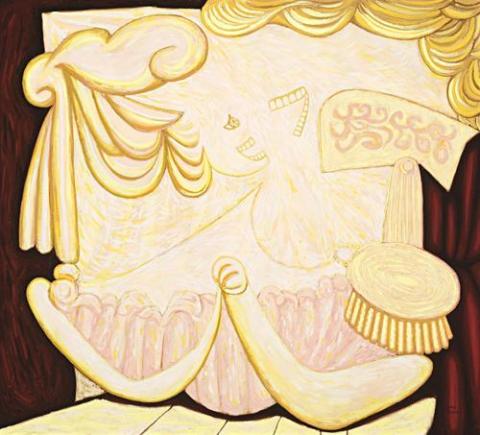DUET, 1961
John Brack
oil on canvas on board
91.5 x 112.0 cm
signed lower right: John Brack
inscribed verso: 'Duet 1961'
Private collection, Melbourne
Paintings by John Brack, South Yarra Gallery, Melbourne, 15 August – 3 September 1961
John Brack: A Retrospective Exhibition, National Gallery of Victoria, Melbourne, 10 December 1987 – 31 January 1988 (label attached verso)
Grishin, S., The Art of John Brack, Oxford University Press, Melbourne, 1990, vol.II, p. 17, cat. o118, p. 117 (illus.)
'I do not know if I am wrong in assuming that relationships between two people 'are always fraught with ambivalence...' they are never a complete union, but there is one occasion in people's lives where there does seem to be a fusion of two people together and that is the wedding day...'1
Exploring moments of orchestrated joy and union within the realm of musical comedy and dance, Duet, 1961 was, interestingly, undertaken by Brack shortly after his Wedding series. Arguably the antithesis of the tenderness and happiness encapsulated in paintings such as The Wedding Breakfast, 1960, the work exposes rather 'a world of artificially intensified emotions and exaggerated expressions of joy and melodramatic tragedy' through 'the chocolate-box glamour of popular entertainment.'2
More broadly, as Helen Brack has written, Duet may be perceived as a continuation of the artist's investigations into the 'myth of love', a theme which culminates in his highly acclaimed ballroom dancing paintings:
'Duet looks at the indelible human desire for romantic happiness, the merging of souls in perfect harmony, redefining the romanticised version of love perfectly expressed in the duets of Nelson Eddy and Jeanette MacDonald during the 1930s and 40s. It develops the idea of pure unadulterated young love contained in The Tram, 1952, and New House, 1953, also linking with the impasto Wedding series, 1960-61, that further describes the myth of love, a dream that everyone colludes in with the uniting of male and female, a series that finished with a picture of intimacy outside of this, The Golden Embrace. The idea was compressed again in the Ballroom Dancing pictures such as Latin American Grand Final, 1969, high in sexual allusion. This is the communal yearning for perfect union and harmony, a forever happiness that is unattainable, does not bear rupture, a yearning that survives.'3
Significantly, it was the Wedding series with its themes of love and sensuousness which first afforded Brack the opportunity to exploit his keen interest in texture painting 'peintres de matière'. With dazzling fields of colour and rich impasto surfaces eroding the last remnants of figuration, the change in direction was no doubt influenced by the American abstract expressionist movement being so highly promoted in Australia at the time. Accordingly, in the present work as well, both stylistically and metaphorically the identities of the entertainers become subsumed, dissolving into a world of surface effects and artifice which alludes perhaps to the guises people assume in order to escape the mundane. As the artist later mused, 'What I am interested in painting is people of course, principally how they live, how they behave, how they get the faces they deserve, how they can bear to put up with a life that seems so curiously tragic.'4
1. Brack cited in interview with Ronald Millar, 1977, p. 10
2. Grishin, S., The Art of John Brack, Oxford University Press, Melbourne, 1990, vol.I, p. 83
3. Helen Brack, 'Essay on Duet', 2003
4. Brack cited in interview with Hazel de Berg, 9 August 1962, p. 356
VERONICA ANGELATOS
